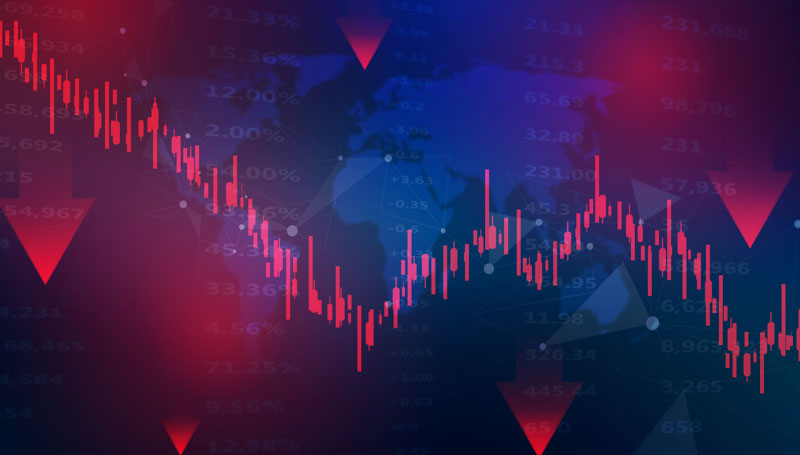

05.01.2022 – Now it has twitched again briefly: After the recent setback of the Nasdaq, the VIX has picked up a bit. But the Volatility Index is still closer to the all-time lows than to the highs. Traders and investors should take a closer look.
Disruptive fire from the bond market
After the small Christmas rally, everything seemed fine again for the bulls: Wall Street rallied, new records were set in the S&P 500, which also declined only slightly yesterday. High-tech stocks, on the other hand, suffered major losses. The setback was triggered by a rise in the yield on 30-year U.S. bonds to 2.1 percent – at the beginning of December, we had seen 1.68. The move yesterday and the day before was a sign of a recovery. The move yesterday and the day before was the strongest gain since the turbulent March of last year. Bond investors are particularly risk averse – if they are going into bonds, something seems to be brewing on the interest rate front and in the overall market.
Against the tide
The VIX fear indicator is trading in the 17-point region, just a shot off its 24-month low of 15.01. At the end of 2017, it had been at an all-time low of 9.14. It can hardly go any lower. The VIX is calculated by the Chicago Board Options Exchange (CBOE) the ratio of call to put options.
In other words, when the good mood is raging, it’s time to swim against the tide. Because when the panic indicator shoots up – we had a high of 82.69 points during the Corona crisis – then it’s possible to cash in. Let’s let two bears have their say and give us an indication of what could be in store for us.
The grizzly among the bears
Michael Wilson of Morgan Stanley, for example, is considered the mega-bear on Wall Street. A grizzly, so to speak. With his negative scenario of 4,000 points for the S&P 500 at the end of 2021, he was way off the mark. At least he correctly predicted the rotation into new stocks and his bank’s Fresh Money Buy List beat the S&P 500 by 300 basis points. Citing Omicron and the fact that the stock market meltup was carried by only a few stocks, Wilson expects a complete “valuation reset” in the stock market this spring. His advice: “Bottom line, when looking for the other side of the large cap defensive barbell, focus more on small/mid cap value rather than small/mid cap growth, particularly with the Fed and other central banks tightening policy.”
Perma-Bear
Investor Dennis Gartman is permanently bearish and generally believes the market is overvalued. Speaking to Bloomberg Radio recently, the Gartman Letter editor said he expects a slow, grinding stock market descent in 2022 as the Federal Reserve goes hawkish. He sees as many as four rate hikes by the Fed, which would have to respond to inflation; most analysts expect three. As a result, stocks could fall about 10 to 15 percent this year. Specifically, “The advent of a bear market will come when the Fed begins to tighten monetary policy, and that will be later this year. No question.” Unfortunately, Gartman has been quite wrong with his assessment over the past six months, which is why the University of Akron fund has been missing out on money, as he was the financial manager in charge of reducing exposure by a tenth. But he may be right this time. Our conclusion: if the VIX dips further in a carefree stock market, it might be worth buying the VIX as a protective put. If only to spare the nerves. The Bernstein Bank wishes good luck!
Important Notes on This Publication:
The content of this publication is for general information purposes only. In this context, it is neither an individual investment recommendation or advice nor an offer to purchase or sell securities or other financial products. The content in question and all the information contained therein do not in any way replace individual investor- or investment-oriented advice. No reliable forecast or indication for the future is possible with respect to any presentation or information on the present or past performance of the relevant underlying assets. All information and data presented in this publication are based on reliable sources. However, Bernstein Bank does not guarantee that the information and data contained in this publication is up-to-date, correct and complete. Securities traded on the financial markets are subject to price fluctuations. A contract for difference (CFD) is also a financial instrument with leverage effect. Against this backdrop, CFD trading involves a high risk up to the point of total loss and may not be suitable for all investors. Therefore, make sure that you have fully understood all the correlating risks. If necessary, ask for independent advice. CFDs are complex instruments and are associated with the high risk of losing money quickly because of the leverage effect. 68% of retail investor accounts lose money trading CFD with this provider. You should consider whether you understand how CFD work and whether you can afford to take the high risk of losing your money.
